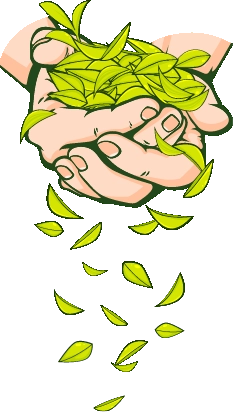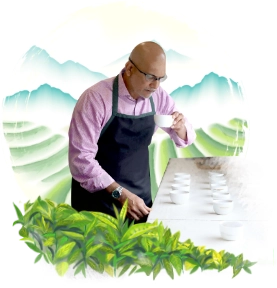It Happens Only In India…The unique Chais that you will only in India
From Assam to Ahmedabad, from Kashmir to Kochi and from Mumbai to Munnar, every region in this tea-fanatic and tea-fuelled land has its own special tea. Created with local ingredients, ingenuity and innovation, influenced with waves of immigration across ages, these tea varieties converge the diversity of the Indian peoples, their complex culture and their myriad traditions into one universal and unified pastime – drinking tea!
Here are these typically ‘Indian chai’ varieties you will find in this colourful and chaotic, but warm, vibrant and vivacious country called India…
Ronga Saah
Ronga (colourful) Saah (cha or tea), this is as basic a tea as it gets. Widely popular in the state of Assam which grows with world-famous Assam Teas, Ronga Saah is a delight for the purist. It is made with fresh luscious tea leaves from of Assam, steeped in boiling water for about 4-5 minutes. The liquor is strained and served in small glass cups or in clay cups. No sugar. No milk. No spices. Just a strong and full bodied cup, robust, bright and brisk.
Outside Assam, Ronga Saah is also called Lal (red) Cha or even Raw Cha in the neighbouring states of West Bengal and Orissa.
Lebu Cha
Particularly loved all over the brilliant and bounteous state of West Bengal, Lebu (lemon) across every nook and corner, Lebu Cha has as many ‘secret’ recipes and ingredients as there are tea-vendors. Every vendor has his own different way of making the perfect Lebu Cha, and each one swears his is the authentic and original!
Lebu Cha is a strong Black tea that is freshly brewed and poured in a small glass or cup. Copious amounts lemon juice from freshly cut is squeezed. Then, a mysterious powder is sprinkled from an unassuming small can – which is generally rock salt mixed with black pepper. Finally, a spoonful of sugar is added and the mixture is stirred vigorously. The result is a delightful explosion of bitter, sweet-salty-sour tea with a subtle hit of pepper. Some vendors also use squeeze in the famous ‘gondhoraj’ (king of fragrance) lime for its tantalising fragrance.
Sulaimani Chai
Sulaimani Chai Thought to have been brought to India in medieval times by Arab traders when they landed along the Malabar coast in south-western India. The early Sulaimani Chai was made with dates and black pepper, called Ghava. Over time, and with the Indian influence, dates got replaced with sugar and a mix of local spices, which the Malabar coast is famous for. With the discovery of tea, Ghava had a new avatar – Sulaimani Chai.
Brewed to a golden amber infusion from black tea, Sulaimani Chai has lots of lemon. Cardamom and black pepper add the flavour and the zing, while a bit of rock salt balances the sweetness of jaggery. Most Sulaimani Chai will have a garnish of a fresh mint leaf or a holy basil leaf which rounds up this deliciously invigorating brew with a soothing herbal aroma. In many places, a few strands of saffron are also put in, which further enhance the golden glow and flavour.
Noon Cha
Noon means salt in the local Kashmiri language, giving this tea its name. Also known as Gulabi (meaning pink) Tea, this is perhaps the only known tea in the world to have baking soda as an ingredient!
Noon Cha is brewed in a Kashmiri samovar using green tea leaves. After being slowly cooked for about 25-30 minutes, a pinch of baking soda is whisked in for a quick ten seconds. More cold water and cardamom are then added and cooked for a few minutes, which give the tea a bright red colour. Then, milk is added to the concoction, magically changing the colour from red to dark pink. Salt is then stirred in. It is then strained into call glasses or cups, and garnished with roughly chopped pistachios and cinnamon powder.
Even though Noon Cha is from Kashmir, it is quite distinct in taste and flavour from the other famous tea from Kashmir – the Kahwa.
Kashmiri Kahwa
Perhaps one of the most well-known products of Kashmir in the world, Kahwa (or Kehwa) is the hot beverages that keeps the beautiful people of Kashmir warm and cheerful all through the year, including the harsh winter months.
This quintessentially traditional Kashmiri drink is brewed with simple ingredients like green tea, green cardamom pods, clove bark/sticks (never powdered), cinnamon and saffron. Sometimes, star anise is also added. Kahwa’s flavour is further enhanced with dried rose petals and a generous share of almonds.
Kahwa is prepared in a traditional brass or copper samovar over burning coal or wood. Water is brought to a boil. All other ingredients are added in and boiled for 3-4 minutes. The vessel is taken off the heat and green tea is added. This is allowed to steep for about 3 minutes. The brew is then strained and poured into transparent cups or small glasses. Crushed or chopped almonds are added as a garnish. Sometimes, walnuts and pistachios are also added. If Kahwa needs to be sweetened, natural honey is preferred over sugar.
The big difference between Noon Cha or Pink Tea and Kahwa is that while Noon Cha is salty and milky, Kahwa doesn’t have either salt or milk.
Gur-Gur Cha
Gur-gur Cha is local variation of Noon Cha or Pink tea from Kashmir that is widely consumed across the Ladakh region. It is a cross-over between Noon Cha of Kashmir and Po Cha of Tibet. The difference between Noon Cha and Gur-gur Cha is the addition of yak butter. The mixture is churned in cylindrical wooden vessel, known as Gur-gur, and hence the name.
Po Cha
Po Cha is the traditional Tibetan tea prepared with yak butter. Po Cha is the only tea in this list where brick tea is used, known as Permagul. Pieces of tea brick are crumbled and boiled slowly in hot water for hours. The brew is then strained and the liquid, known as Chaku, kept aside for making Po Cha.
To make Po Cha, Chaku is added to boiling water. While this is boiling, salt is added. After 2-3 minutes, it is taken off the heat. Milk and butter from female yaks is then added. The mixture is then poured into a large covered vessel and churned for 2-3 minutes. In Tibet, they say that the longer Po Cha is churned, the better it tastes!
Metre Cha
This has to be one of the most theatrical and dramatic teas in the world! It is neither the ingredients or nor the tea, but the style in which it is poured from one container to the other that makes it so mesmerising and fascinating.
Metre Cha actually refers to the unit of measure – one metre. In South India, across the numerous tea shops, one can always find a crowd of eager and surprised onlookers staring with amazement as the tea maker first boils black tea, strains it, adds sugar and hot milk. Nothing special till now. And then, he pours this into a long metal tumbler with a handle. He pours this into a similar tumbler that he holds in his other hand. In a practised rhythm, he keeps pouring from one to the other, each time, increasing the distance between the two vessels, progressively stretching his arms. in about 4-5 pours, the tea from one tumbler held at the top of outstretched hand cascades into the other tumbler held way below in the other hand, travelling free-flow over a distance of one metre! And not a drop is spilled. The frothy tea is then poured into small glasses to admiring customers.
Gavati Chaha
Gavati Chaha literally means lemongrass tea. This is usually a very light tea had without milk or sugar. When the tea is being steeped, chopped lemongrass is added in the tea-pot or the pan. The fresh fragrance of lemongrass gets infused with the tea, and makes a soothing aromatic tea.
Kesar Chai
It there was ever a royal preparation of tea, it has to be Kesar Cha. Kesar (saffron) is one of the most expensive spices known to man. Kesar Cha is served on special occasions like marriages or during the auspicious festival of Diwali. Being served a cup of Kesar Cha means you are definitely amongst the most respected and elite guests of the household.
Kesar Chai is made with pure milk which is boiled with strands of saffron. The milk is cooked for at least 10 minutes to let the water evaporate and make the milk creamier. At around half-way stage, when the milk has acquired a golden tinge, best quality of Assam CTC tea is added with generous amounts of sugar, and cooked for another 5 minutes. This is then strained and served. Kesar Cha is thick, strong and creamy, with a distinct golden hue and wafting saffron aroma.
Irani Chai
The tea gift of the Parsi community to India, Irani Chai derives its name from Iran (ancient Persia) from where the Parsis fled ages ago due to religious persecution, and landed on the western shores of India.
Today, Irani Chai is found across old cafés in Mumbai as well as in Hyderabad and Secunderabad. What makes Irani Chai different and unique is its nostalgia and tradition. Unlike other hot teas, Irani Chai is cooked with spices like cardamom, cloves, star anise and cinnamon in sealed containers using steam. The aroma tells the tea master when the brew is ready. It is then transferred to another sealed container where the entire liquid including the brewed tea and spices is ‘hung’ over a cloth. This slowly drips the concentrated, strong and coppery tea in the bottom half of the container. To this concentrated tea, hot milk that is whisked with evaporated milk or milk solids, is added, to make a delightfully creamy, milky cup of tea. The usual serving size is 90 ml, and Irani Chai is also popularly called Chai 90ml. Sugar is generally added as a default option.

Tea is a religion in the art of life.

